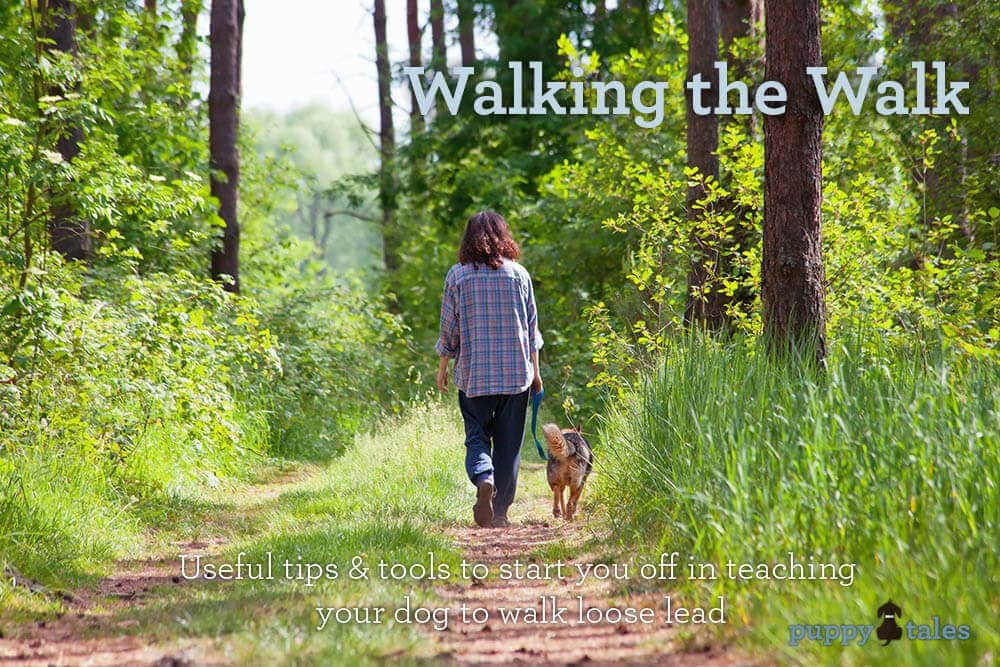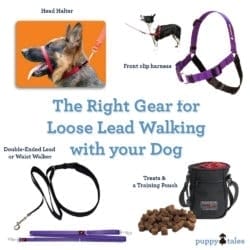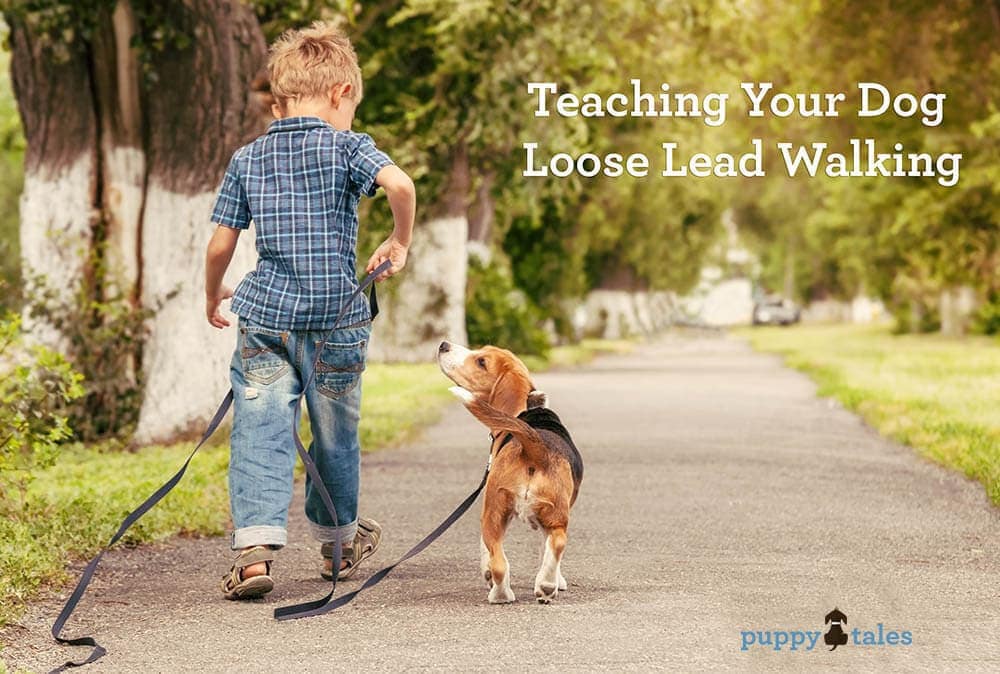Loose lead walking can be one of the most challenging activities to teach your dog. Nevertheless it’s important training. Being dragged around the streets by your dog is not only frustrating but it can also be dangerous. You have the increased risk of being pulled over, injuring your shoulders or arms, or having to let go of the leash if that’s your only saviour in a difficult situation! These useful tips and tools will start you off in teaching your dog to walk loose lead.

The Right Gear for Loose Lead Walking
Before you get started with training your dog to walk nicely on a loose lead, let’s have a look at the equipment that you are using to make sure that they are right for you and your dog. Here are a few tools that you will aid in teaching and walking your dog on a loose lead:
- A Double-Ended Lead or Waist Walker. Using a double-ended lead allows you to clip the lead around the waist. A waist walker is similarly designed so that it can be worn around your waist and some allow for walking multiple dogs. Both leads mean that your thighs control the strength of the dog not your arms, upper back or neck and that you have your hands free.
- A Front clip harness. This style of harness is great for large and/or strong dogs. You clip the leash at the dog’s chest (not on the dogs back) and this design means that when the dog pulls, it will curve towards back towards you, rather than pulling ahead like a sled dog.
- Head Halter, like the Canny Collar. Dog halters are designed to prevent or reduce pulling. Not all dogs will like a head halter, so it can be best to consult a dog trainer if your dog is not adapting well to wearing the collar. I’ve tested a few head halters over the years and have found the Canny Collar to be the one that has been accepted by dogs most frequently. The Canny Collar design allows for the lead to be clipped behind your dogs head rather than under the chin. As this means it will not ride up into your dogs eyes or yank their head to one side it is more comfortable for your dog.
- Collar or harness. Depending on the size, strength and current lead training of your dog the collar or harness that you currently have may be sufficient for training loose lead walking.
- Treats and training pouch. Take a combination of treats out with you in your training pouch. Now that you have your hands free from holding the leash you’ll find it far easier to can start walking and treating.

One piece of equipment that many people have that won’t work in training for loose lead walking is a retractable lead. Retractable leads are great for working on recall training at the off-leash park, but are very inconsistent if you allow your dog 2 metres of lead length one minute, then 5 metres, then back to 2 metres and so on….
Before Starting with Loose Lead Walking
There are a few pre-requisites that you will need to teach your dog before embarking on loose-lead walking training sessions they include:
- Getting your dog’s attention in all sorts of circumstances.
- Teaching your dog to sit while having the lead attached before a walk. Pulling will always be an issue if you don’t teach your dog to sit and be calm before heading off for a walk.
- Teaching a release word when you walk out the front gate. This should stop your dog from barging past you or pulling you onto the street or footpath. I use the word “ok” to let my dogs know when they can exit the gates and doors.
Teaching Your Dog Loose Lead Walking
- Once you can attach the lead and your dog sits quietly, then you can begin to proceed walking towards the gate with your dog. If your dog starts getting excited, ask your dog to sit and reward them until you are able to walk to the gate with your dog in a calm manner.
- At the gate, again ask your dog to wait. Once doing so, show them a stop hand signal (an upright flat vertical palm, facing the dog), open the gate and give a verbal “ok” release before your dog jumps out of position. This teaches your dog to wait to hear the word “ok” before exiting the gate.If you find that your dog is unable to remain calm or sit before leaving home, detach the lead and practice getting your dogs focus (try teaching positive name recognition) until your dog is calm.
- From this point onward the lead must remain loose. When starting it’s a good idea to avoid heading towards your dogs favourite park. Instead set your dog up for success by heading off in the opposite direction. Take one step, ask your dog to sit and reward your dog with a treat, take another step, reward and continue to reward any calm behaviour and anytime that the lead is loose.The best approach to eliminate pulling is to simply stop moving. Freeze whenever your dog is in front of you and begins to pull. Wait until the lead slackens and then start to move again. It is important that you reward every little move that your dog makes to slacken the lead and pay attention to you (looks back at you, turns to face you, walks toward you).
- Take a few steps at a time and give your dog a verbal cue to let them know that they can have a sniff, have a toilet break, or whatever it is your dog enjoys doing. My verbal cue is “free”. Saying the word “free” gives my dogs permission to walk ahead and have a good sniff if they wish. Dogs love to sniff, and so teaching them that they can have the freedom to explore with their noses when they have been walking nicely on a loose lead can be used as part of your reward system.
- Repeat this a few times- take a few steps walking on a loose lead, then say “free” and let your dog sniff, go to the toilet, or even have a roll on the grass, regain their attention and repeat.
- You can lure your dog back to you by pointing your finger to your side, say the word “close” then start off on loose lead walking again.
- The more progress you see, the more steps you continue to add before you give the “free” cue. Once you add more steps, continue rewarding this fabulous behaviour with treats. You will find that your dog will probably see the benefit in walking nicely on a loose lead as you will not be stopping as much- so your dog gets to continue its journey forward, it gets treats (double bonus), and is allowed to have a sniff after doing such a great job (triple bonus).

At the start be sure to maintain a high rate of reinforcement (giving treats) when your dog is in the desired position, and when it makes eye contact with you on walks. Progress in small increments: don’t ask for too much too soon. Once you are both on a role and you are seeing some improvements, reduce the number of treats that you give to your dog, but always let your dog know that it is doing a great job by giving your dog some sort of verbal recognition, such as “good dog, well done”!
When using this training method, it is best to take frequent walks each day rather than once a day. I work on loose lead walking on weekends, and of an afternoon during the week when I have more time to dedicate to the practice. On the weekends I might allocate 3 x 10 minute walks per day that are entirely dedicated to loose lead walking. If I am too rushed of a morning during the week I will drive to the park instead of walking in order to set my dogs up for success.
If your dog is deliberately pulling you toward something that is highly desirable (the front gate, tree, another dog, etc.), simply turn around and walk back to the starting point. Only continue toward what your dog is headed for if the lead is loose or every time your dog pulls take a few steps backwards. Most dogs will turn and move back towards their owner. When the lead slackens, start walking forward.
Try not to get frustrated; remember that patience and consistency are the keys to success! If you are not in the right frame of mind to practice this method of training, drive to the off-leash park instead and work on loose lead walking when you are in the right frame of mind.
Good luck!

Michelle O’Brien
Michelle started her career at the age of 14 as an Animal Attendant and in her early 20’s became a Veterinary Nurse. Her dog training career started 12 years ago when she was offered the opportunity to run puppy preschool classes.
Michelle’s training qualifications centre around positive reinforcement methods, being a Delta Canine Good Citizen Trainer and gaining a Certificate IV in Companion Animal Services. Michelle is also a member of the Delta Professional Dog Trainers Association.


